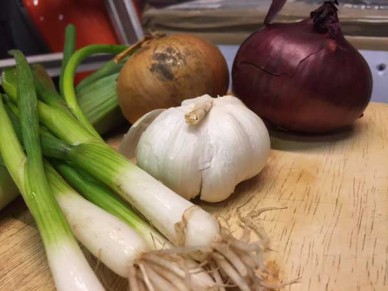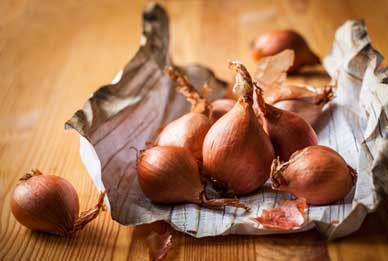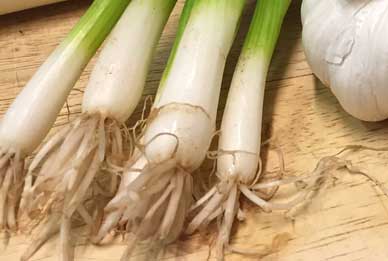Know your onions: Growing onions, leeks, shallots and garlic

The genus Allium to which the onion belongs also boasts members including shallots, garlic, leeks and chives as well as many ornamental varieties that can be used to create colour and structure in a garden planting scheme.
Onions in their various forms are the most widely used of vegetables worldwide. There is barely a main course recipe that doesn’t include them in some form or another whether sautéed, baked, fried or raw and for that reason every self-respecting grower should have an area reserved for this most versatile of vegetables.
General growing advice for alliums
The ground needs to be well drained and prepared with manure or other organic material well ahead of planting. Choose a sunny, open location with a near neutral (6.5-6.8) PH soil. Prepare soil with organic matter several months ahead of planting, especially if using horse manure – this improves soil texture and introduces nutrients. Heavy soil may also need some sand to help it drain more freely. A week or so before planting add a general fertiliser and rake in.
Onions and shallots can be grown from seed but many prefer to use sets which are immature bulbs. Sowing from sets is a popular option as it often produces bigger bulbs that can be harvested earlier. They also tend to be more resistant to disease but can be prone to bolting – producing a flowerhead – which is not desirable. Some cultivars are specially heat-treated to prevent this happening so try to find these if possible. When planting sets or cloves consider covering them with fleece for a couple of weeks while they establish to discourage birds or animals from digging them up.
What sets don’t give you is the range of varieties available as seeds so, if you want to experiment, seeds are the way to go.
As their tall thin foliage doesn’t cast much shade weeds can be a problem too. Keep weeds under control throughout the growing season being especially careful when the shoots of your plants are young as they are easily confused.
Many of the alliums have varieties that can be planted at different times of year. Late autumn plantings will give an earlier spring crop while those planted in early spring will extend the harvest into summer.
If flower heads do appear snip them off as soon as possible.
TIP: Practice crop rotations. Don’t grow alliums in a plot that has been recently used to cultivate any other members of the family as this will encourage disease. See the section at the end of the article for a summary of the most common problems affecting the onion family.
Yellow, red and white onions
Yellow onions, sometimes known as brown onions, are easily the most widely grown. Medium in intensity, these will caramelise easily and sweeten as they are cooked, enhancing the flavour of any recipe they are added to. Red onions tend to be milder in flavour and pungency and are often used raw in salads and in salsas. White onions can have a more pungent taste but do have more tender flesh than both yellow or red. They are interchangable with yellow onions in most recipes. Growing advice is the same for all three varieties.

If necessary brush away soil or mulch as the bulb matures
Growing
Sow seeds into compost filled pots in early February or into the ground in late March. Onions germinate best in warm temperatures (18-25 C) and should begin to show after 1-2 weeks. Try not to expose them to temperatures below 10 C for more than a few days as this amy encourage bolting later on. As the shoots appear move to a cool, light and airy position, keeping the compost barely moist. If temperatures allow, plants can be moved outside during the day to harden then off.
Plant out early May into a well prepared, finely raked soil. Plant at 4” (10cm) intervals in rows 12” (30cm) apart. Water in and apart from a bit of weeding, the occasional water and a monthly feed of blood fish and bone (one handful per sg metre), that’s pretty much all you’ll need to do.
Sets can be started in early spring, simply pushed into loose earth and covered to leave just the tips showing. Plant 4” (10cm) – 6” (15cm) apart with 1’ (30cm) between rows.
Onions are prone to rotting if there is too much moisture in the ground and only require additional watering when there is a prolonged dry spell. Once the bulbs are swollen you should cease watering altogether and brush soil from around the top of the bulbs to start the drying process and encourage dormancy
Harvest
Once the leaves have yellowed and toppled you can harvest after about 2 weeks. Once lifted they will need to be dried. Drying can be done either outside if the weather is fine, avoiding direct harsh sunlight, or inside in a dry, airy place if rain is expected. Leave them on racks or newspaper for a couple of weeks until the skins have that familiar papery texture. They can then be stored in a cool light, but not bright, place tied into plaits or in mesh bags. They can last like that for many weeks or months.
Shallots

Growing advice is much the same as for onions but rather than sets producing just one bulb they will often develop six to eight.
Spring onions
Spring onions, also known as scallions or salad onions, are small mild onions that a popular for use in salads and oriental stir-fry cooking. Some growers will pick their main crop onions early and use them in the same way but there are now cultivars specially developed to produce perfect, easy to grow, onions with just the right flavour characteristics.

Spring onions are prefect for a salad or stir-fry
In reality, spring onions and scallions are slightly different with spring onions forming a small bulb and milder scallions staying completely straight. For the purposes of this article we will group them together as the method of growing is exactly the same. Spring onions can be grown indoors, outdoors, in pots or in the ground with equal success.
Contrary to what the name might suggest there are varieties of spring onion that will over-winter well and be ready to harvest late spring. White Lisbon is a popular variety that can be grown throughout the year.
Another difference between spring onions and larger main crop varieties is that the green leaves can also be used to add flavour, colour and texture to your cooking.
Growing
Rake the soil to a fine tilth and make drills approx 1/4″ (6mm) deep and 6″ (15cm) apart. Sown thinly (5mm intervals) there should be no need to thin. You can start sowing in March for summer cropping or September for overwintering varieties that can be harvested in Spring.
Harvest
Don’t wait for the leaves to discolour, pick when they are around 6″ (5cm) tall. Leaving spring onions in the ground too long will change their taste making them stronger and more pungent.
Garlic
Another almost omniscient ingredient in many world cultures, garlic has a strong, distinctive flavour. An ingredient in countless recipes from across the continents it is also used to flavour oils, breads and dips as well as being used roasted, smoked or raw in stuffings for meat, poultry and olives. Garlic also believed to have medicinal properties including possible benefits in reducing blood pressure and cholesterol levels. It is also widely used to maintain intestinal health in chickens and horses.
There are two types of garlic, hard neck, which produce a non-flowering flower stem (called a scape), and soft neck. Most will opt for a soft neck variety as they generally produce more cloves and store better. Scapes from hard neck varieties can be cut and used in the kitchen as you would use spring onions.
Viable garlic seeds are a rarity so nearly all homegrown garlic will be grown from cloves. Don’t use bulbs from the supermarket as results are likely to be disappointing, instead source bulbs produced specifically for growing from seed merchants or garden centres.
Growing
Garlic can be planted in October/November for Autumn planting varieties and January to March for Spring planting. Harvesting will be in June or July.

Separate individual cloves out from the bulb at the time of planting. Plant about 1” (2.5cm) deep with the flat (root) part of the clove facing downwards. Space cloves at 4” (10cm) intervals in rows 12” (30cm) apart.
Garlic will only need watering during long dry periods and, as with onions, you should stop watering completely as the bulbs mature.
If space is at a premium in the garden garlic can be grown in pots. 4 cloves in an 8 inch pot filled with standard growing compost is plenty. Don’t overcrowd. Pots will need watering more regularly than the garden, keep compost moist, but not wet, to discourage rotting.
Harvesting
Harvest bulbs when the leaves turn yellow and topple over. Loosen the ground around each bulb carefully with a hand fork before lifting. As with onions the bulbs should be left to dry somewhere airy out of the direct sunlight before storing in mesh bags or as plaited strings.
Leeks
Not as pungent as most other members of the onion family but a tasty, versatile vegetable that goes well in soups, casseroles and pies or just smothered in cheese sauce as a side dish. Leeks will happily sit in the ground all winter long ready for you to use when needed.

Growing
Leeks like the same, free draining, sunny, open environment as other onions. Seeds can be sown undercover in pots from January or February or direct into the ground from March. Sow 1” (2.5cm) down in rows about 12” (30cm) apart and thin seedlings when they have 3 leaves. They will be ready to transplant when they are pencil (8mm) thick in May or June. To transplant make a hole deep enough so that the area where the leaves separates isn’t covered (approx 6”), drop seedlings into the hole and fill with water which will wash soil over the roots. That’s it, there is no need to backfill the holes. Keep on top of the weeds and water regularly especially during prolonged dry spells. Tip: apply a general fertiliser to the soil about a week before transplanting seedlings.
Harvest
You can harvest small leeks in summer for salads but most will be allowed to grow for the main crop to be harvested in autumn and winter. To make harvesting easier when the weather is cold choose a time when the ground is not frozen to dig up some of your leeks and then heel them in again where they will keep for a number of weeks or months and be easier to pull. Just dig a shallow trench and lay your leeks in it closely packed together. Recover with soil and firm down.
Companion planting
An onion smell can deter many insects and this works particularly well when planted with members of the brassica family such as broccoli, cabbage and cauliflower. Mint, in turn, deters, or perhaps confuses, the onion fly if your area is susceptible. You can also intercrop onions with peppers and tomatoes.
Other good companion plants include carrots and lettuce due to the fact that their roots reside at different levels in the soil and are non-competitive. Don’t allow companion plants to shade out your onions.
Onions seem to inhibit growth in peas and beans so this combination is best avoided
Pest and disease
Members of the allium family tend to be quite hardy and largely unaffected by pests and diseases but a few to watch out for are listed here.
Onion white rot: Soil-borne fungus characterised by yellowing of foliage. Underground roots rot and a fluffy white fungal growth with spots of black appears on the base of the bulb. All infected plants should be destroyed and alliums should not be grown into same areas for 8-10 years. Be careful not to infect other areas by moving earth or via dirty garden equipment.
Leek rust: Another fungus which causes yellow or orange spots on the leaves. Can be caused by wet or humid conditions. Mild infections won’t necessarily harm plants but if it gets hold destroy plants and don’t grow alliums in the same position for 3 years
Onion fly: the maggot-like larvae eat into the base of the onion killing it. Prematurely yellow or drooping leaves are a good indication that something is wrong and a quick check underneath will confirm the presence of the maggots. Covering developing plants with fleece stops the flies laying eggs and is a good precaution or grow from sets as these are less likely to be affected.
Most recent Growing articles
- Five unusual and versatile vegetables to grow this spring 24th January, 2016
- Composting: what is it and why should you be doing it? 02nd November, 2015
- Know your onions: Growing onions, leeks, shallots and garlic 15th June, 2015
- Growers’ yearbook December – edible hedgerows and other ideas 01st December, 2014
- Growers’ yearbook November 04th November, 2014
- Growers’ Yearbook: October 04th October, 2014







Leave a reply